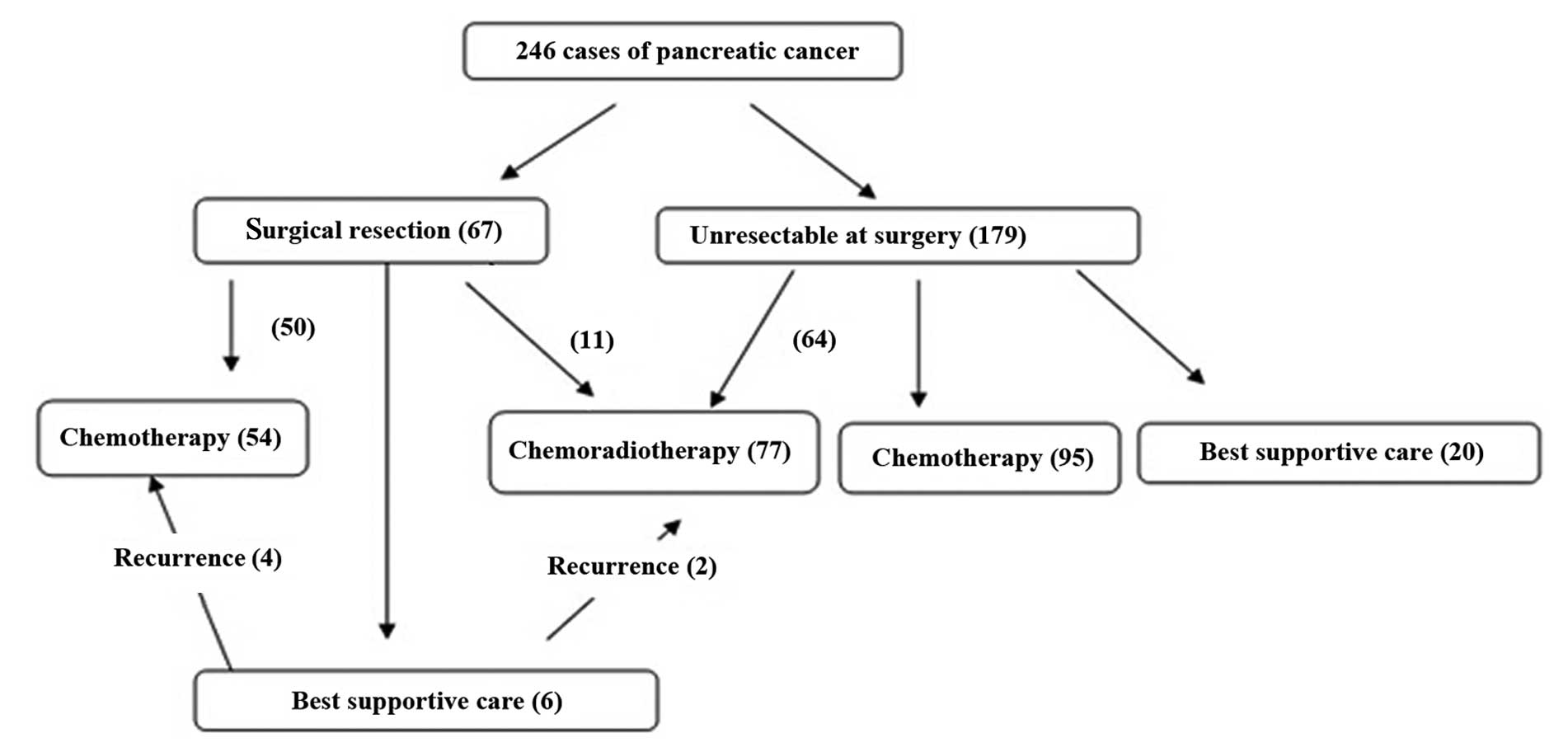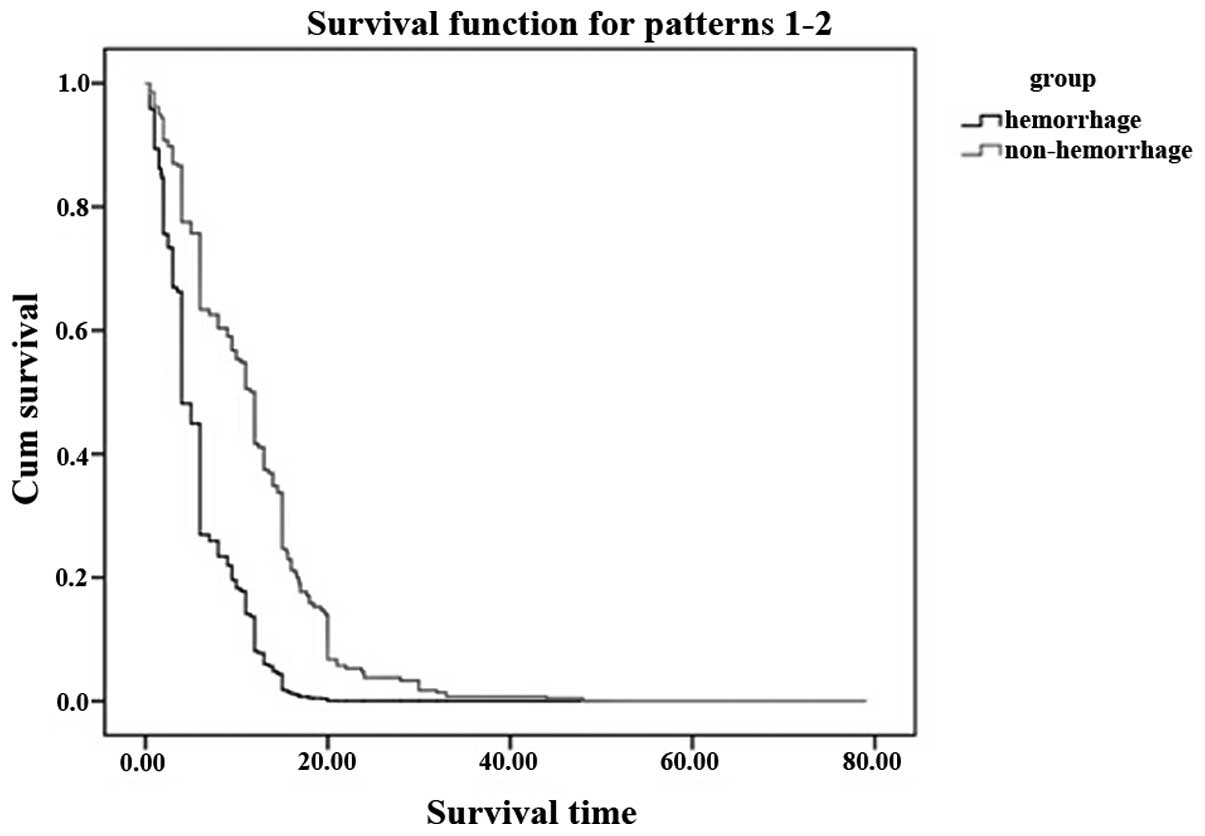|
1
|
Jemal A, Siegel R, Ward E, Hao Y, Xu J and
Thun MJ: Cancer statistics, 2009. CA Cancer J Clin. 59:225–249.
2009. View Article : Google Scholar : PubMed/NCBI
|
|
2
|
Olowokure O and Qi X: Pancreatic cancer:
Current standards, working towards a new therapeutic approach.
Expert Rev Anticancer Ther. 14:495–497. 2014. View Article : Google Scholar : PubMed/NCBI
|
|
3
|
Winek T, Hamre D, Mozell E and Vetto RM:
Prognostic factors for survival after pancreaticoduodenectomy for
malignant disease. Am J Surg. 159:454–456. 1990. View Article : Google Scholar : PubMed/NCBI
|
|
4
|
Rockey DC: To transfuse or not to
transfuse in upper gastrointestinal hemorrhage? That is the
question. Hepatology. 60:422–424. 2014. View Article : Google Scholar : PubMed/NCBI
|
|
5
|
Longstreth GF: Epidemiology and outcome of
patients hospitalized with acute lower gastrointestinal hemorrhage:
A population-based study. Am J Gastroenterol. 92:419–424.
1997.PubMed/NCBI
|
|
6
|
Longstreth GF: Epidemiology of
hospitalization for acute upper gastrointestinal hemorrhage: A
population-based study. Am J Gastroenterol. 90:206–210.
1995.PubMed/NCBI
|
|
7
|
Wollenman CS, Chason R, Reisch JS and
Rockey DC: Impact of ethnicity in upper gastrointestinal
hemorrhage. J Clin Gastroenterol. 48:343–350. 2014. View Article : Google Scholar : PubMed/NCBI
|
|
8
|
Fallah MA, Prakash C and Edmundowicz S:
Acute gastrointestinal bleeding. Med Clin North Am. 84:1183–1208.
2000. View Article : Google Scholar : PubMed/NCBI
|
|
9
|
Greenspoon J, Barkun A, Bardou M, Chiba N,
Leontiadis GI, Marshall JK, Metz DC, Romagnuolo J and Sung J:
International Consensus Upper Gastrointestinal Bleeding Conference
Group: Management of patients with nonvariceal upper
gastrointestinal bleeding. Clin Gastroenterol Hepatol. 10:234–239.
2012. View Article : Google Scholar : PubMed/NCBI
|
|
10
|
Cooper GS, Chak A, Way LE, Hammar PJ,
Harper DL and Rosenthal GE: Early endoscopy in upper
gastrointestinal hemorrhage: Associations with recurrent bleeding,
surgery and length of hospital stay. Gastrointest Endosc.
49:145–152. 1999. View Article : Google Scholar : PubMed/NCBI
|
|
11
|
Simoens M, Gevers AM and Rutgeerts P:
Endoscopic therapy for upper gastrointestinal hemorrhage: A state
of the art. Hepatogastroenterology. 46:737–745. 1999.PubMed/NCBI
|
|
12
|
Longstreth GF and Feitelberg SP:
Outpatient care of selected patients with acute non-variceal upper
gastrointestinal haemorrhage. Lancet. 345:108–111. 1995. View Article : Google Scholar : PubMed/NCBI
|
|
13
|
Silverstein FE, Gilbert DA, Tedesco FJ,
Buenger NK and Persing J: The national ASGE survey on upper
gastrointestinal bleeding. II. Clinical prognostic factors.
Gastrointest Endosc. 27:80–93. 1981. View Article : Google Scholar : PubMed/NCBI
|
|
14
|
Laine L, Yang H, Chang SC and Datto C:
Trends for incidence of hospitalization and death due to GI
complications in the United States from 2001 to 2009. Am J
Gastroenterol. 107:1190–1195; quiz 1196. 2012. View Article : Google Scholar : PubMed/NCBI
|
|
15
|
Charbonnet P, Toman J, Bühler L, Vermeulen
B, Morel P, Becker CD and Terrier F: Treatment of gastrointestinal
hemorrhage. Abdom Imaging. 30:719–726. 2005. View Article : Google Scholar : PubMed/NCBI
|
|
16
|
Bone RC, Balk RA, Cerra FB, Dellinger RP,
Fein AM, Knaus WA, Schein RM and Sibbald WJ: The ACCP/SCCM
Consensus Conference Committee. American College of Chest
Physicians/Society of Critical Care Medicine: Definitions for
sepsis and organ failure and guidelines for the use of innovative
therapies in sepsis. Chest. 101:1644–1655. 1992. View Article : Google Scholar : PubMed/NCBI
|
|
17
|
Davenport RJ, Dennis MS and Warlow CP:
Gastrointestinal hemorrhage after acute stroke. Stroke. 27:421–424.
1996. View Article : Google Scholar : PubMed/NCBI
|
|
18
|
Shinchi H, Takao S, Noma H, Matsuo Y,
Mataki Y, Mori S and Aikou T: Length and quality of survival after
external-beam radiotherapy with concurrent continuous
5-fluorouracil infusion for locally unresectable pancreatic cancer.
Int J Radiat Oncol Biol Phys. 53:146–150. 2002. View Article : Google Scholar : PubMed/NCBI
|
|
19
|
Li CP, Chao Y, Chi KH, Chan WK, Teng HC,
Lee RC, Chang FY, Lee SD and Yen SH: Concurrent chemoradiotherapy
treatment of locally advanced pancreatic cancer: Gemcitabine versus
5-fluorouracil, a randomized controlled study. Int J Radiat Oncol
Biol Phys. 57:98–104. 2003. View Article : Google Scholar : PubMed/NCBI
|
|
20
|
Chauffert B, Mornex F, Bonnetain F,
Rougier P, Mariette C, Bouché O, Bosset JF, Aparicio T, Mineur L,
Azzedine A, et al: Phase III trial comparing intensive induction
chemoradiotherapy (60 Gy, infusional 5-FU and intermittent
cisplatin) followed by maintenance gemcitabine with gemcitabine
alone for locally advanced unresectable pancreatic cancer.
Definitive results of the 2000–01 FFCD/SFRO study. Ann Oncol.
19:1592–1599. 2008. View Article : Google Scholar : PubMed/NCBI
|
|
21
|
Lee KJ, Kim HM, Jung JW, Chung MJ, Park
JY, Bang S, Park SW, Lee WJ, Seong JS and Song SY: Gastrointestinal
hemorrhage after concurrent chemoradiotherapy in locally advanced
pancreatic cancer. Gut Liver. 7:106–111. 2013. View Article : Google Scholar : PubMed/NCBI
|
|
22
|
Crane CH, Abbruzzese JL, Evans DB, Wolff
RA, Ballo MT, Delclos M, Milas L, Mason K, Charnsangavej C, Pisters
PW, et al: Is the therapeutic index better with gemcitabine-based
chemoradiation than with 5-fluorouracil-based chemoradiation in
locally advanced pancreatic cancer? Int J Radiat Oncol Biol Phys.
52:1293–1302. 2002. View Article : Google Scholar : PubMed/NCBI
|
|
23
|
Huguet F, Girard N, Guerche CS, Hennequin
C, Mornex F and Azria D: Chemoradiotherapy in the management of
locally advanced pancreatic carcinoma: A qualitative systematic
review. J Clin Oncol. 27:2269–2277. 2009. View Article : Google Scholar : PubMed/NCBI
|
|
24
|
Cheung J, Yu A, LaBossiere J, Zhu Q and
Fedorak RN: Peptic ulcer bleeding outcomes adversely affected by
end-stage renal disease. Gastrointest Endosc. 71:44–49. 2010.
View Article : Google Scholar : PubMed/NCBI
|
|
25
|
Toke AB: GI bleeding risk in patients
undergoing dialysis. Gastrointest Endosc. 71:50–52. 2010.
View Article : Google Scholar : PubMed/NCBI
|
















